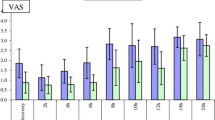Abstract
Purpose: Pain and emesis are the two major complaints after day surgery. Local anesthesia has become an important part of optimizing perioperative pain treatment. The aim of the present study was to study two different concentrations of levobupivacaine’s effect on postoperative pain following elective arthroscopy of the knee with lidocaine 10 mg/ml with adrenaline as active control. Type of study: Prospective, randomized double-blind study with lidocaine as active control but without placebo. Methods: One hundred and twenty patients were studied comparing levobupivacaine 2.5 mg/ml, levobupivacaine 5 mg/ml, and lidocaine 10 mg/ml with adrenaline given intra-articularly at the end of day-case operative elective arthroscopy of the knee done in light general anesthesia. Primary study endpoint was the need for any analgesics during the first 24 postoperative hours. Results: Levobupivacaine 5 mg/ml was associated with a reduced need for any analgesia during the entire 24-h study period (p = 0.013) as compared to both 2.5 mg/ml levobupivacaine and lidocaine with adrenaline. Levobupivacine 2.5 mg/ml was inferior to lidocaine with regard to pain relief with an increase in need for oral analgesia already during stay in the recovery unit (p < 0.001). Conclusions: Levobupivacaine 5 mg/ml was found to be an effective local anesthetic in day-case operative arthroscopy of the knee providing superior postoperative analgesia as compared to lidocaine with adrenaline or a lower concentration of levobupivacaine. Level of evidence: Level I: Prospective, randomized double-blind study without placebo.

Similar content being viewed by others
References
Apfelbaum JL, Chen C, Mehta SS, Gan TJ (2003) Postoperative pain experience: results from a national survey suggest postoperative pain continues to be under managed. Anesth Analg 97:534–540
Ates Y, Kinik H, Binnet MS, Ates Y, Canakci N, Kecik Y (1994) Comparison of prilocaine and bupivacaine for post-arthroscopy analgesia: a placebo-controlled double blind trial. Arthroscopy 10:108–109
Casati A, Borghi B, Fanelli G et al (2003) Interscalene brachial plexus anesthesia and analgesia for open shoulder surgery: a randomized, double-blinded comparison between levobupivacaine and ropivacaine. Anesth Analg 96:253–259
Collins SL, Moore RA, McQuay HJ (1997) The visual analogue pain intensity scale; what is moderate pain in millimetres? Pain 72:95–97
Dernedde M, Stadler M, Bardiau F, Boogaerts J (2003) Continuous epidural infusion of large concentration/small volume versus small concentration/large volume of levobupivacaine for postoperative analgesia. Anesth Analg 96:796–801
Foster RH, Markham A (2000) Levobupivacaine: a review of its pharmacology and use as a local anesthetic. Drugs 59:551–579
Gandhi TK, Weingart SN, Borus J et al (2003) Adverse drug events in ambulatory care. N Engl J Med 348:1556–1564
Gristwood RW (2002). Cardiac and CNS toxicity of levobupivacaine: strengths of evidence for advantage over bupivacaine. Drug Saf 25:153–163
Ivani G, DeNegri P, Conio A et al (2002) Comparison of racemic bupivacaine, ropivacaine and levo-bupivacaine for pediatric caudal anesthesia: Effects on postoperative analgesia and motor block. Reg Anesth Pain Med 27:157–161
Jacobson E, Forssblad M, Rosenberg J, Westman L, Weidenhielm L (2000) Can local anesthesia be recommended for routine use in elective knee arthroscopy? A comparison between local, spinal, and general anesthesia. Arthroscopy 16:183–190
Kalso E (1996) Better standardisation will improve the quality of analgesic studies. Acta Anaesthesiol Scand 40:397–398
Kalso E, Smith L, McQuay HJ, Andrew Moore R (2002) No pain, no gain: clinical excellence and scientific rigour–lessons learned from IA morphine. Pain 98:269–275
Kelly AM (2001) The minimum clinically significant difference in visual analogue scale pain score does not differ with severity of pain. Emerging Med J 18:205–207
Moiniche S, Mikkelsen S, Wetterslev J, Dahl JB (1999) A systematic review of intra-articular local anesthesia for postoperative pain relief after arthroscopic knee surgery. Reg Anesth Pain Med 24:430–437
Rautoma P, Santanen U, Avela R, Luurila H, Perhoniemi V, Erkola O (2000) Diclofenac premedication but not intra-articular ropivacaine alleviates pain following day-case knee arthroscopy. Can J Anaesth 47:220–224
Redmond M, Florence B, Glass PS (2003). Effective analgesic modalities for ambulatory patients. Anesthesiol Clin North Am 21:329–346
Rosseland LA, Stubhaug A, Grevbo F, Reikeras O, Breivik H (2003) Effective pain relief from intra-articular saline with or without morphine 2 mg in patients with moderate-to-severe pain after knee arthroscopy: a randomized, double-blind controlled clinical study. Acta Anaesthesiol Scand 47:732–738
Santanen U, Rautoma P, Luurila H, Erkola O (2001) Intra-articular ropivacaine injection does not alleviate pain after day-case knee arthroscopy performed under spinal anaesthesia. Ann Chir Gynaecol 90:47–50
Shang AB, Gan TJ (2003) Optimizing postoperative pain management in the ambulatory patient. Drugs 63:855–867
Shiwa SS, MacLeod BA, Day B (1989) Intraarticular bupivacaine (Marcaine) after arthroscopic meniscectomy: a randomized double-blind study. Arthroscopy 5:33–35
Sinardi D, Chillemi S, Marino A, Trimarchi G (2002) 0.25% levo-bupivacaine for interscalene block during shoulder surgery: a survey on 20 patients. Minerva Anestesiol 68:589–592
Author information
Authors and Affiliations
Corresponding author
Rights and permissions
About this article
Cite this article
Jacobson, E., Assareh, H., Cannerfelt, R. et al. The postoperative analgesic effects of intra-articular levobupivacaine in elective day-case arthroscopy of the knee: a prospective, randomized, double-blind clinical study. Knee Surg Sports Traumatol Arthrosc 14, 120–124 (2006). https://doi.org/10.1007/s00167-005-0655-4
Received:
Accepted:
Published:
Issue Date:
DOI: https://doi.org/10.1007/s00167-005-0655-4




